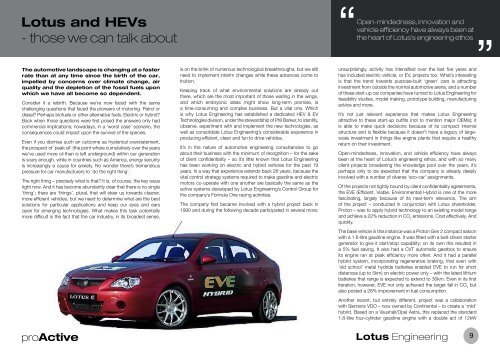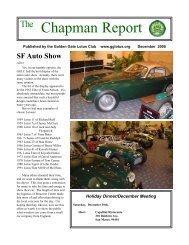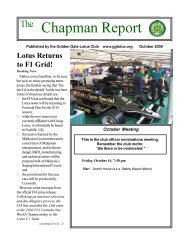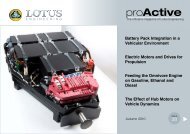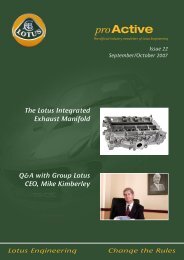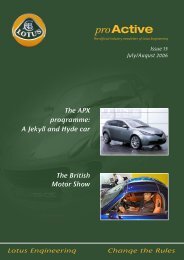Pro Active
Pro Active
Pro Active
Create successful ePaper yourself
Turn your PDF publications into a flip-book with our unique Google optimized e-Paper software.
Lotus and HEVs<br />
- those we can talk about<br />
The automotive landscape is changing at a faster<br />
rate than at any time since the birth of the car,<br />
impelled by concerns over climate change, air<br />
quality and the depletion of the fossil fuels upon<br />
which we have all become so dependent.<br />
Consider it a rebirth. Because we’re now faced with the same<br />
challenging questions that faced the pioneers of motoring. Petrol or<br />
diesel? Perhaps biofuels or other alternative fuels. Electric or hybrid?<br />
Back when those questions were first posed the answers only had<br />
commercial implications; nowadays, in a ‘worst case’ scenario, the<br />
consequences could impact upon the survival of the species.<br />
Even if you dismiss such an outcome as hysterical overstatement,<br />
the prospect of ‘peak oil’ (the point where cumulatively over the years<br />
we’ve used more oil than is left underground) within our generation<br />
is scary enough, while in countries such as America, energy security<br />
is increasingly a cause for anxiety. No wonder there’s tremendous<br />
pressure for car manufacturers to ‘do the right thing’.<br />
The right thing – precisely what is that? It is, of course, the key issue<br />
right now. And it has become abundantly clear that there is no single<br />
‘thing’; there are ‘things’, plural, that will steer us towards cleaner,<br />
more efficient vehicles, but we need to determine what are the best<br />
solutions for particular applications and keep our eyes and ears<br />
open for emerging technologies. What makes this task potentially<br />
more difficult is the fact that the car industry, in its broadest sense,<br />
pro<strong>Active</strong><br />
is on the brink of numerous technological breakthroughs, but we still<br />
need to implement interim changes while these advances come to<br />
fruition.<br />
Keeping track of what environmental solutions are already out<br />
there, which are the most important of those waiting in the wings,<br />
and which embryonic ideas might show long-term promise, is<br />
a time-consuming and complex business. But a vital one. Which<br />
is why Lotus Engineering has established a dedicated HEV & EV<br />
Technologies division, under the stewardship of Phil Barker, to identify,<br />
observe, experiment with and implement the new technologies, as<br />
well as consolidate Lotus Engineering’s considerable experience in<br />
producing efficient, clean and fun to drive vehicles.<br />
It’s in the nature of automotive engineering consultancies to go<br />
about their business with the minimum of recognition – for the sake<br />
of client confidentiality – so it’s little known that Lotus Engineering<br />
has been working on electric and hybrid vehicles for the past 19<br />
years. In a way that experience extends back 26 years, because the<br />
vital control strategy systems required to make gasoline and electric<br />
motors co-operate with one another are basically the same as the<br />
active systems developed by Lotus Engineering’s Control Group for<br />
the company’s Formula One racing activities.<br />
The company first became involved with a hybrid project back in<br />
1990 and during the following decade participated in several more;<br />
“ Open-mindedness, innovation and<br />
vehicle efficiency have always been at<br />
the heart of Lotus’s engineering ethos<br />
”<br />
unsurprisingly, activity has intensified over the last five years and<br />
has included electric vehicle, or EV, projects too. What’s interesting<br />
is that the trend towards purpose-built ‘green’ cars is attracting<br />
investment from outside the normal automotive arena, and a number<br />
of these start-up car companies have turned to Lotus Engineering for<br />
feasibility studies, model making, prototype building, manufacturing<br />
advice and more.<br />
It’s not just relevant experience that makes Lotus Engineering<br />
attractive to these start-up outfits (not to mention major OEMs); it<br />
is able to make quick decisions because of its compact internal<br />
structure and is flexible because it doesn’t have a legacy of largescale<br />
investment in things like engine plants that require a healthy<br />
return on their investment.<br />
Open-mindedness, innovation, and vehicle efficiency have always<br />
been at the heart of Lotus’s engineering ethos, and with so many<br />
client projects broadening the knowledge pool over the years, it’s<br />
perhaps only to be expected that the company is already deeply<br />
involved with a number of diverse ‘eco-car’ assignments.<br />
Of the projects not tightly bound by client confidentiality agreements,<br />
the EVE (Efficient. Viable. Environmental) Hybrid is one of the more<br />
fascinating, largely because of its near-term relevance. The aim<br />
of the project – conducted in conjunction with Lotus shareholder,<br />
<strong>Pro</strong>ton – was to apply hybrid technology to an existing model range<br />
and achieve a 22% reduction in CO 2 emissions. Cost effectively. And<br />
quickly.<br />
The base vehicle in this instance was a <strong>Pro</strong>ton Gen 2 compact saloon<br />
with a 1.6-litre gasoline engine. It was fitted with a belt-driven starter<br />
generator to give it start/stop capability; on its own this resulted in<br />
a 5% fuel saving. It also had a CVT automatic gearbox to ensure<br />
its engine ran at peak efficiency more often. And it had a parallel<br />
hybrid system, incorporating regenerative braking, that even with<br />
‘old school’ metal hydride batteries enabled EVE to run for short<br />
distances (up to 5km) on electric power only – with the latest lithium<br />
batteries that range is expected to extend to 30km. Even in its first<br />
iteration, however, EVE not only achieved the target fall in CO 2 but<br />
also posted a 28% improvement in fuel consumption.<br />
Another recent, but entirely different, project was a collaboration<br />
with Siemens VDO – now owned by Continental – to create a ‘mild’<br />
hybrid. Based on a Vauxhall/Opel Astra, this replaced the standard<br />
1.8-litre four-cylinder gasoline engine with a double act of 12kW<br />
Lotus Engineering


